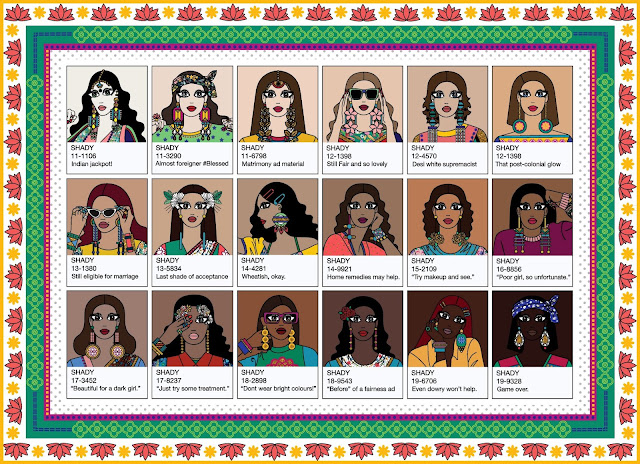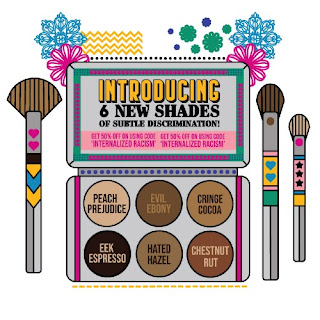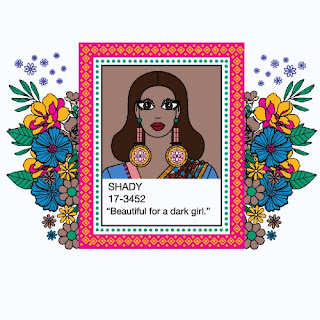The country’s fixation with light skin is a brazen cocktail of colorism, patriarchy and residual colonialism.
Illustrations by Srishti Guptaroy for BRIGHT MagazineWhen I was born, my paternal grandmother wrote a letter to my maternal grandfather: “A girl is born. She is dark-complexioned. You better prepare for her future.”It is not clear if my grandfather was offended by the doomsday prophecy for the dark-skinned me, or if he just wanted to win the upper hand. He wrote back to her, “Those who think [her future is bleak] should look at their faces in a dirty puddle.” His response created a rift between my paternal and maternal family that has never healed.I grew up in north India in the 1990s. My Brahmin family was full of government servants who were still carrying the colonial white man’s burden of racial prejudices and superiority complexes. Growing up in the close proximity of a large extended family, I was the only dark child. “Kaali-kaluti, baigan looti / Blacky-black smeared, she robbed the color of an eggplant,” my cousins would taunt when they wanted to have a laugh at my expense. I laughed along with them, eager to fit in.
My skin color was particularly concerning to my mother, since we were an upper-caste Brahmin family. Anytime someone would call me dark, my fair-skinned mother would correct them and tell them I was “wheatish,” one of the many euphemisms in India for brown skin. It was her way of comforting herself that her daughter was a tad bit higher in the hierarchy than truly dark people.
Fair skin has long been part of India’s national psyche. The various settlers, rulers, invaders, and colonizers who entered India starting in the 1400s were relatively light-skinned. This includes the Dutch, French, Portuguese, Mughals, and of course, the British, who were in India from the 17th century until India’s independence in 1947. During the British Empire, skin tone prejudice became formally engrained; the colonizers kept light skinned Indians as allies, giving them extra advantages over the rest of the “blacks.” The British East India Company even named their settlement at Fort St. George “White Town” and their Indian settlement “Black Town.”
The British colonizers were able to build on India’s existing caste system, a socio-economic hierarchy with origins in Hinduism but which now permeates across Indian society. The upper castes like the Brahmins and Kshatriyas were traditionally powerful (and also fair-skinned), while lower castes (including the “untouchable” Dalits) performed manual tasks and had darker complexions. I know this dichotomy intimately; growing up, my relatives would often look at me and say, “Never trust a dark-skinned Brahmin or a fair-skinned Dalit.”
Kathy Russell Cole, author of the book, “The Color Complex: The Politics of Skin Color in a New Millennium,” notes that many people from lower castes have darker skin because for generations, they have been subjected to hard physical labor in the sun. Since caste and class often intersect, fair skin is also perceived as being evidence of “better financial and social status of a person.”
India’s colorist attitudes have not gone anywhere. Politicians continue to make color-based prejudices based on geography and caste. Gendered colorism, in which dark-skinned women face particular discrimination, directs job and marriage prospects. And Indians continue to lighten their skin, using a variety of creams, bleaches, and homemade products. Is there any way to remedy India’s obsession with skin color?
…
During a trip to a north Indian village, an old woman walked up to me to say, “Every morning, at 5 a.m., you should drink half a cup of fresh, non-boiled cow milk. The complexion of your child-to-be will be fair.” I plastered a smile on my face. I was not even pregnant. But colorism runs so deep that this was the best advice she thought to offer me.
Women have passed on similar age old “wisdom” to attain fairness for generations. “Apply gram flour, milk, and turmeric on her face daily,” my mother was told when I was a kid, so I “would not look like a Madrasananymore.” Madrasan refers to a person from the southern city of Madras, now Chennai. North Indians are typically lighter skinned than South Indians, who live in a hotter climate. Colorism exacerbates this geographical divide.
Colorism also has a pervasive impact on job and marriage opportunities. Fair people are perceived as more presentable. In 2008, the state of Maharashtra sponsored 100 dark-skinned tribal girls to train as flight attendants. Only eight of them were eventually recruited, that too as ground staff — likely in part due to their complexion. Similarly, the description of women in the arranged marriage market often includes skin tone shorthand like: f = fair, vf = very fair, and vvf = very very fair. (This practice is not as rampant for prospective grooms.)
Ratna Soren, a 24-year-old anthropology student from Hazaribagh, a small district in the eastern state of Jharkhand, is seen as a misfit in her family because she is still single. All her younger cousins are married. She has used Fair & Lovely since she was 4 years old. “It still hasn’t changed my complexion,” she says. This has elicited incessant rejections from prospective grooms. “I am seen as a burden on my family. A girl with dark complexion must have more dowry to offer if she wants to get married in India,” she says, getting emotional. “My parents cannot afford it.”
In some extreme cases, colorism has even taken lives. In 2014, a woman in a posh suburb of Delhi hanged herself because her husband abused her for being dark-skinned. The same year, a schoolteacher named Brototi Das set herself on fire, fed up with the constant humiliation she suffered from her family for her dark complexion. Yet another woman poisoned the foodduring a family function, killing five, allegedly tired of her family’s taunts over her skin color. All of these women were under the age of 25.
Their ages are notable. Though colorism is often considered a colonial relic, young Indians can be just as guilty of perpetuating it. In a 2015 essay, author Neha Mishra cited a survey that asked Indians between the ages of 20–25 to describe “pretty.” 71 percent of those surveyed used words such as “fair” or “light.” The survey also revealed that the pressure to look fair is much higher on Indian women than men.
…
Color discrimination has also played a huge role in the world’s most prodigious film industry. Bollywood films often feature songs that glorify fair skin and deride darker skin shades. For instance, in the 1990s film “Suhaag,” the male protagonist lusts after women with fair skin and dark sunglasses. A more recent song talks about how the two lead actors’ hearts start beating fast upon seeing “white white faces.”
Most actors who have dominated India’s film industry have been fair-skinned, particularly the women, from Madhubala in the 1960s to Kareena Kapoor and Katrina Kaif today. To make matters worse, some of these actors also make extra income by endorsing “fairness” products, further perpetuating the notion that when it comes to the complexion, lighter is simply better.
“Dark skin has been a source of stigma for Indian women long before the arrival of globalization,” say Radhika Parameswaran and Kavitha Cardoza, authors of a paper about India’s obsession with light skin. “However, the intensified promotion of light-skinned beauty in advertising since the onset of economic liberalization points to the role that market forces can play in exacerbating divisions of gender, caste, region, and class.”
…
India’s skin whitening market is expected to achieve an annual market revenue of $720 million by 2023. It is currently dominated by Fair & Lovely, a fairness cream that was launched in 1975 and which today holds more than 50 percent market share. Fair & Lovely has long marketed itself as the savior for unmarried women to find grooms — and for married women to keep them.Hindustan Unilever, the multinational conglomerate that produces it, has not shied away from using blatant colorism to sell its products. A controversial 1990 ad features a young Indian woman who is heartbroken when she hears her father say, “Kaash beta hota / If only I had a son.” She runs to her bedroom crying, where she sees a television ad for Fair & Lovely. The advertisement cuts to the protagonist, now happy with her lighter skin, making more money, and taking her parents out to dinner. The father beams approvingly. A brazen cocktail of colorism and patriarchy, the ad was heavily criticized when it aired for shamelessly exploiting the aspirations of Indian women, and for pinning financial and romantic success on fair skin.
Recent Fair & Lovely ads do not contain this blatant misogyny, but instead drip with corporate-led feminism; they suggest fair skin as a tool for female success. You can become a pilot, a district collector, or a rich athlete by using their product. And in a bid to increase profits, they offer products to lighten other parts of Indian women. The company now sells armpit lightening cream — and even vagina lightening cream.
An estimated 60 percent of Indian women — and 10 percent of men — say they use fairness products. Alarmed by the health dangers of fairness products, the World Health Organization began to study and promote the strict regulation of these creams. It noted that mercury, a common ingredient found in skin lightening soaps and creams, can cause rashes, kidney damage, and even cancer.
Some skin lightening procedures in India include chemical peeling, laser treatment, bleaching, and fairness injections. In 2016, Shalini Verma took a three-month course to lighten her skin just before her wedding. Her picture that had been sent along with the marriage proposal was lightened by several shades through Photoshop, as is common practice. She would not meet her groom until their wedding day, and Shalini says that she didn’t want to disappoint him. “He was taking me to USA, my dream country,” she says. “Taking a few injections on my face, if it pleases him, is no big deal.”
There are other explanations too, like choice feminism. “If I want to be fair, I should be allowed to, right? What is so Western about it?” asks Divya Bahl, a 30-year-old corporate communication executive. She undergoes chemical peels of dark spots at least four times a year. “I want to look good,” she says. “So whatever it takes.”
…
Beyond the physical risks, Kavitha Emmanuel, founder of the campaign “Dark is Beautiful,” warns that color bias creates a mental health epidemic. “Western stereotypes about young people’s looks, their skin color, their hair type is making young Indians struggle for their identity,” Emmanuel says. “They face low self-esteem, feel bad and hopeless about themselves, and retreat into a shell.”
Fortunately, there are small signs of progress. After sustained campaigns against fairness cream ads, the Advertising Standards Council of India issued guidelines in 2014, stating that “ads should not reinforce negative social stereotyping on the basis of skin color” or “portray people with darker skin [as]…inferior, or unsuccessful in any aspect of life particularly in relation to being attractive to the opposite sex.”
Akanksha Verma, a 32-year-old model based in Delhi, says she initially struggled to find assignments because of her dark skin. “I was always told that my complexion is not suited for luxury brands,” she recalls. “It is only after these debates around colorism that I get to endorse luxury clothing brands.”
A news anchor, who requested anonymity to protect her professional reputation, told me that she was restricted from presenting news on air for almost a decade because of her complexion. “Since the discourse [on colorism] in the last five years changed, my editors realized that I was sharper at news debates and finally let me anchor news shows,” she says. “Though, the woman anchor on prime time continues to be the fair one.” She says the same parameter has not applied to men. “Beautiful Indian men are supposed to be tall, dark, and handsome,” she says. “Not women.”The “Dark is Beautiful” campaign has also pushed companies to change their tactics. Simran Nagpal, an advertising professional, says that in order to avoid controversy, many fairness creams are now repackaged as brightness or glow creams. “A lot of cosmetics companies, in order to project a progressive image, do not advertise their fairness products but continue to have them in their offerings,” she says. “They want to at least pretend to be on the right side of things.”
There have also been global campaigns like “Unfair and Lovely,” which invited women to post their pictures on social media to celebrate dusky and dark skin tones.
But progress is never a straight line. In June 2017, research firm Global Industry Analysts released a report projecting that global spending on skin lightening will triple to $31.2 billion by 2024. India and China have the highest estimated growth rate. The driving force, the report says, is “the still-rampant darker skin stigma, and a rigid cultural perception that correlates lighter skin tone with beauty and personal success.”
…
As a dark girl who did not use bleaching or fairness products, my family thought I spent my life compensating for my “unfortunate” complexion. Whether it was doing well in school, riding a heavy power scooter (unthinkable for a teenage girl in small-town India), or being the first girl in the family to pursue higher education in another city, not having to worry about protecting my skin turned out to be a blessing in disguise.I have been able to hold a steady career as a journalist, be financially independent, and be the first girl in my extended family to choose her own life partner — all seen as ways I have made up for not being “good looking,” or more accurately, light-skinned.
My dark complexion turned out to be a ticket to freedom.





